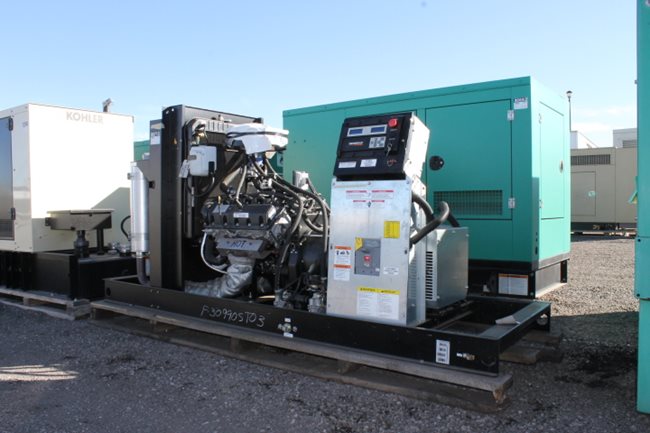|
 In addition to ensuring that the generator frequency matches the frequency of the grid or appliances, the following conditions must also be satisfied: In addition to ensuring that the generator frequency matches the frequency of the grid or appliances, the following conditions must also be satisfied:
(a) Output voltage of the generator must match the operating voltage of the grid, or the appliances powered by the generator.
(b) There should be no phase difference between the grid voltage and that of the generator.
To understand the conversion of a three-phase generator to a single-phase one and vice versa, let us first take a brief look at the internal configuration of these two kinds of generators.
Single-Phase Generators:
In a single-phase generator, the stator has a number of windings connected in series to form a single circuit across which the output voltage is generated.
• Equal voltage across all stator windings in phase with each other
For instance, in a 4-pole generator, the four poles of the rotor are evenly spaced around the frame of the stator. At any given point in time, each rotor pole is in the same position relative to the stator windings as any other rotor pole. Hence, the voltages induced in all the stator windings are of the same value and amplitude and also in phase with each other at every time.
• Series connection of stator windings
Also, since the windings are connected in series, the voltages produced in each winding add up to produce a final generator output voltage that is four times the voltage across each of the individual stator windings.
Single-phase power distribution is commonly used in residential areas and also in rural areas where loads are small and uncommon and the cost of setting up a three-phase distribution network is high.
 Three-Phase Generators: Three-Phase Generators:
In a three-phase generator, three single-phase windings are spaced such that there is a phase difference of 120° among the voltages induced in each of the stator windings. The three phases are independent of each other.
• Star or Y Configuration
In a star or Y connection, one lead from each winding is connected to form the neutral. The opposite end of each winding, known as the finish end, is connected to a line terminal each. This produces a line voltage greater than the individual voltage across each winding.
• Delta Configuration
In a delta configuration, the start end of one phase is connected to the finish end of the adjacent phase. This produces a line voltage equal to the phase voltage. Electrical utilities and commercial generators produce three-phase power.
Phase Conversion in Generators:
(1) Reconfiguring Coil Connection
A three-phase generator can be converted to a single-phase one by altering the connection between its stator windings inside or outside the generator head. For instance, in the case of a 3-phase generator, you would have 6 leads. Larger generators commonly have 12 leads from six coils and all the wires come out of the generator making it easier to configure the generator in a variety of ways as follows –
• Connecting the coils in series will convert the generator to a single-phase one.
• By connecting opposite coils in series, you can double the output voltage.
• A parallel connection will double the flow of current.
The tricky part of reconfiguring a generator lies in mapping the wires emerging from the generator to the coils they are connected to. It is necessary to have the manufacturer’s documents. Else, you would need to study how your generator is currently wired and work backwards from there.
(2) Centre-Tapping Single-Phase Loads To Three-Phase Generators
A three-phase generator can be viewed as a combination of three single-phase units. Single-phase loads can be connected to a three-phase generator in one of the following ways –
f665.jpg) • Connect the load between a phase conductor and the system neutral. This is usually done for low-power loads. • Connect the load between a phase conductor and the system neutral. This is usually done for low-power loads.
• Connect the load across two live conductors in a phase-to-phase connection. This is usually done for high-power loads such as air conditioners or heaters and provides 208 V. However, this may lead to poor performance since appliances require 240 V for operation would run at 75% of their rated capacity at 208 V.
(3) Phase Convertors:
A rotary phase convertor (RPC) can be directly connected to a single-phase generator to produce three-phase power supply. It requires a simple configuration comprising two input connections, known as idler inputs from a single-phase generator. A voltage is produced on the third terminal that is not connected to the single-phase power. The induced voltage differs in phase from that on the other two terminals by 120°.
(4) Variable speed drives (VSDs) / variable frequency drives (VFDs) / Inverters
These are similar to rotary phase convertors. The VFD-single-phase generator combination is most effective in the case of applications that require less than 20 horsepower.
Choosing Between Single-Phase and Three-Phase Generators
The output of single-phase generators is usually limited to 25 kVA. At higher ratings, it is less expensive to draw single-phase power supply from a three-phase generator than to buy dedicated single-phase units for higher loads. Read the following article, Tips on Buying Used Generators, to help find the proper generator for any situation.
The choice between a single-phase and a three-phase output is solely dependent on the kind of application to be powered. Single-phase generators are best suited for single-phase output whereas a three-phase generator can easily provide both single- and three-phase power. If all your appliances operate on single-phase power, it makes sense to choose a single-phase generator. If you need to operate appliances that work on different phases, a three-phase generator will serve you best. However, it is essential to account for load balances while stepping up a single-phase generator to a three-phase unit.
|